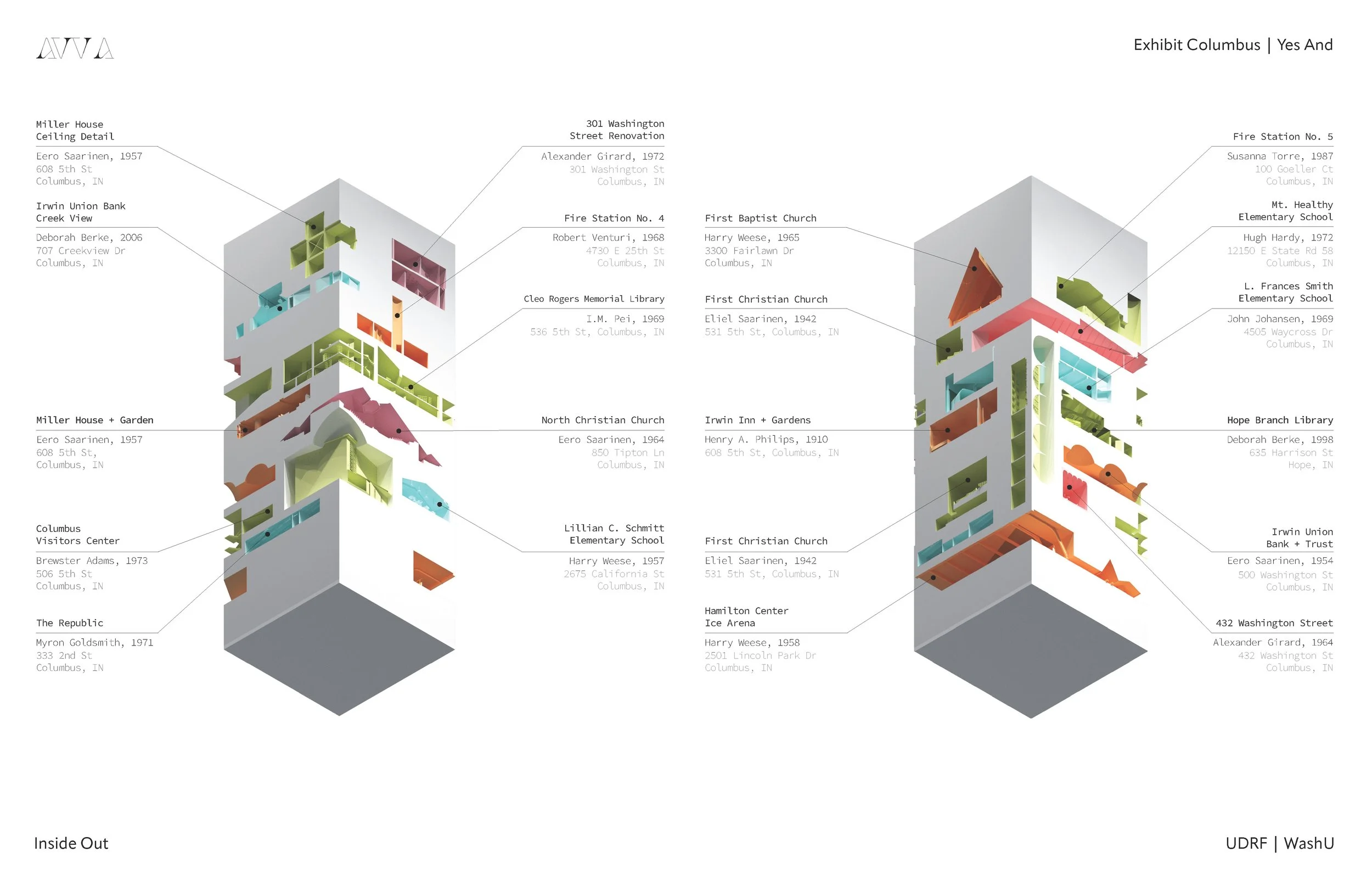University Design Research Fellowship
Inside Out by Chandler Ahrens, Constance Vale, and Kelley Van Dyck Murphy
Inside Out draws on the playful work of Alexander Girard with this multi-story dollhouse, which presents a visual collection of Columbus’ architectural legacy. Alongside his well-known textiles, Girard created a three-story dollhouse in creative exchange with his brother Tunsi for the iconic Miller House and Garden. Colorful dolls inhabit the Miller’s dollhouse interiors, and a nearby carpet illustrates the family’s stories, arranging icons that recall different events that shape their collective identity.
Columbus is an architectural archive, with its buildings scattered throughout the city. Yet, its significant interiors remain hidden as privatized spaces or are less well-known than their exteriors. This dollhouse turns the city’s architecture inside out, revealing its interiors. New dolls, designed by Columbus’s youth and painted by their counterparts in St. Louis, animate the dollhouse, representing the city’s diverse inhabitants.
A multi-level playground, recalling Girard’s rug at the Miller House, surrounds the dollhouse, allowing young visitors to climb up and view the upper levels. Like Girard’s rug, the design incorporates Columbus’s community stories, weaving the city’s unique and varied identities into the project. This interactive installation invites imagination and discovery, reflecting Columbus’ collective identity, and offers a playful way to engage with its architectural history.
Location: St. Louis, Missouri
University: Washington University in St. Louis College of Architecture Sam Fox School
Site: Columbus Area Visitors Center
Partner: Bartholomew County Public Library
Site Accessibility: This exhibit is located on flat ground that is easily accessible. Portions of the exhibit are up to 8 feet high and may be difficult to see at a seated level.










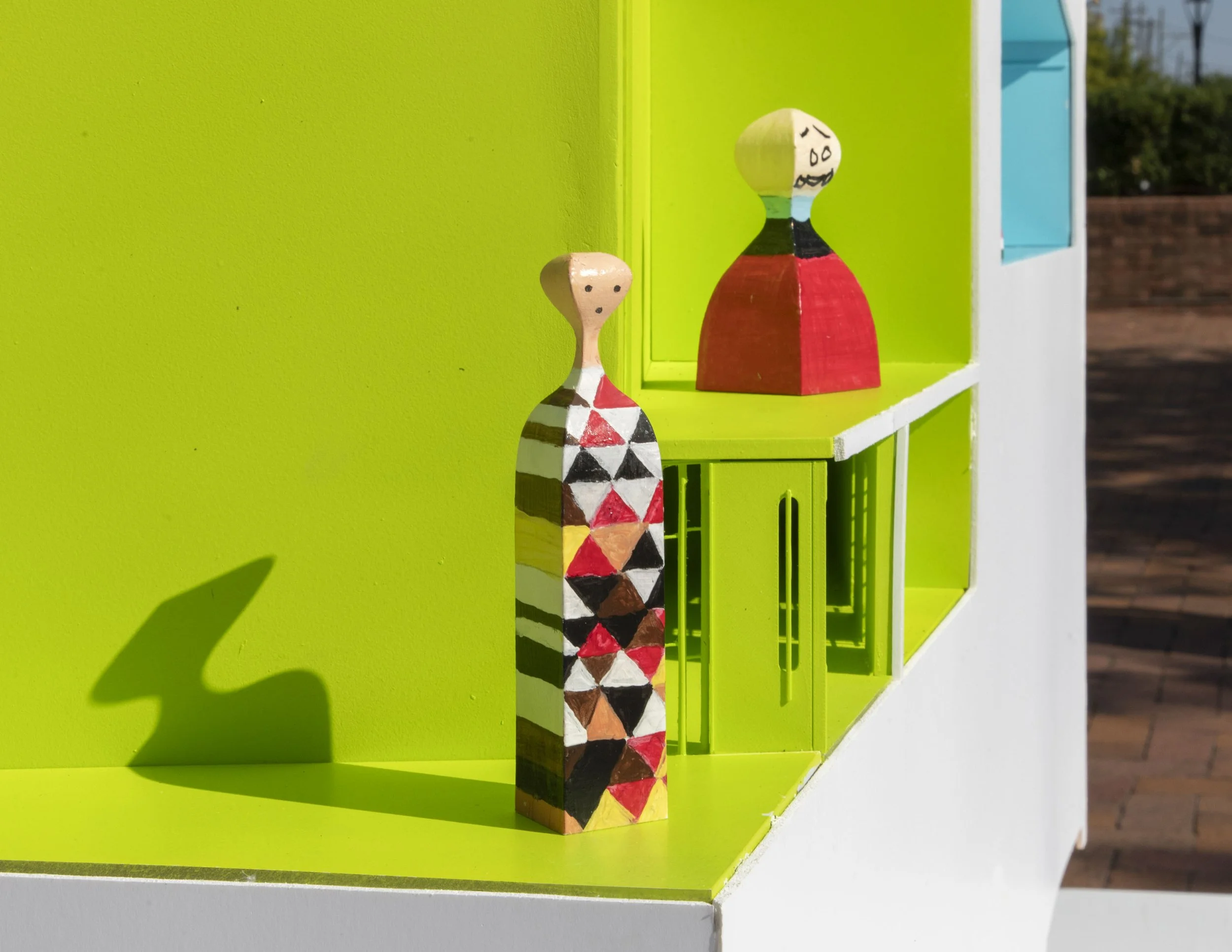
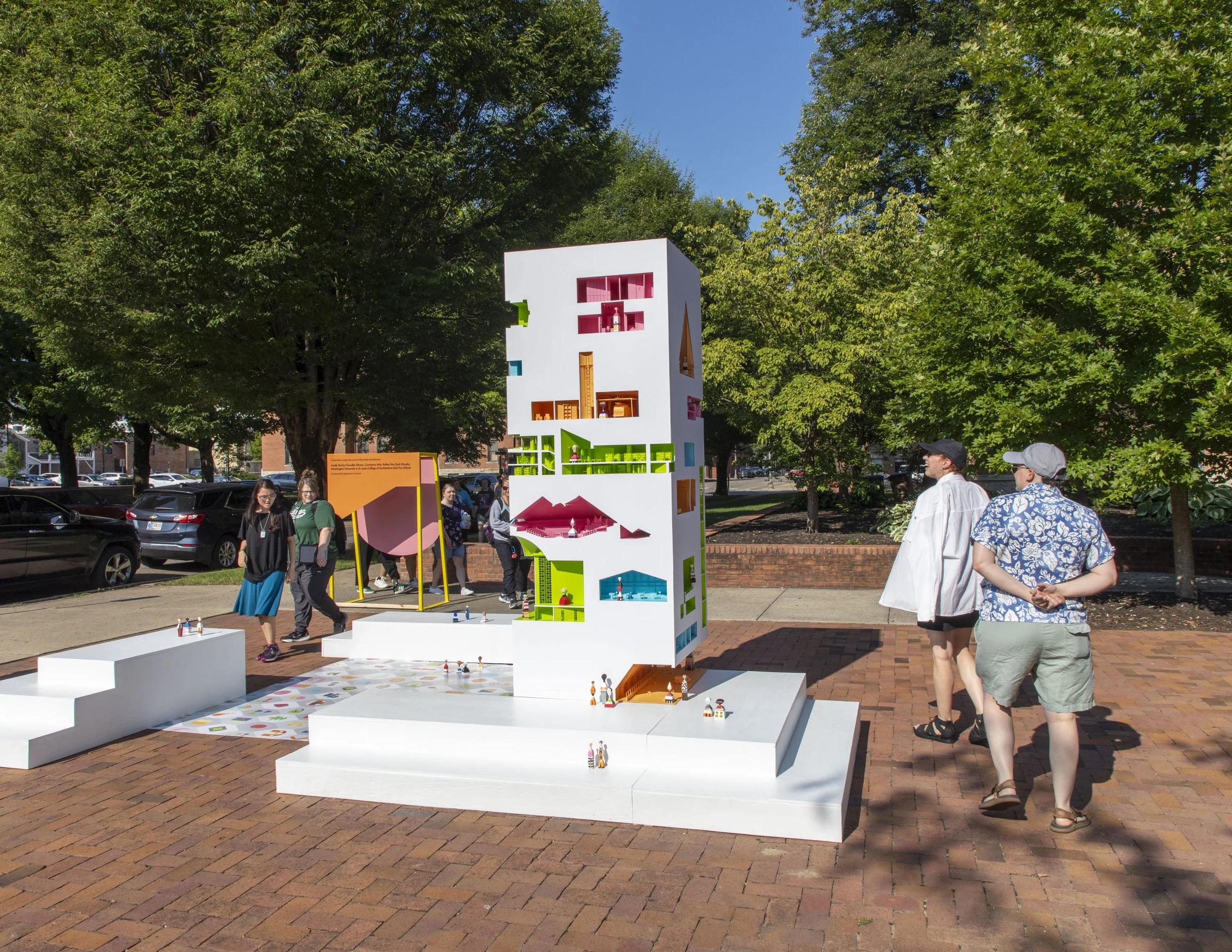
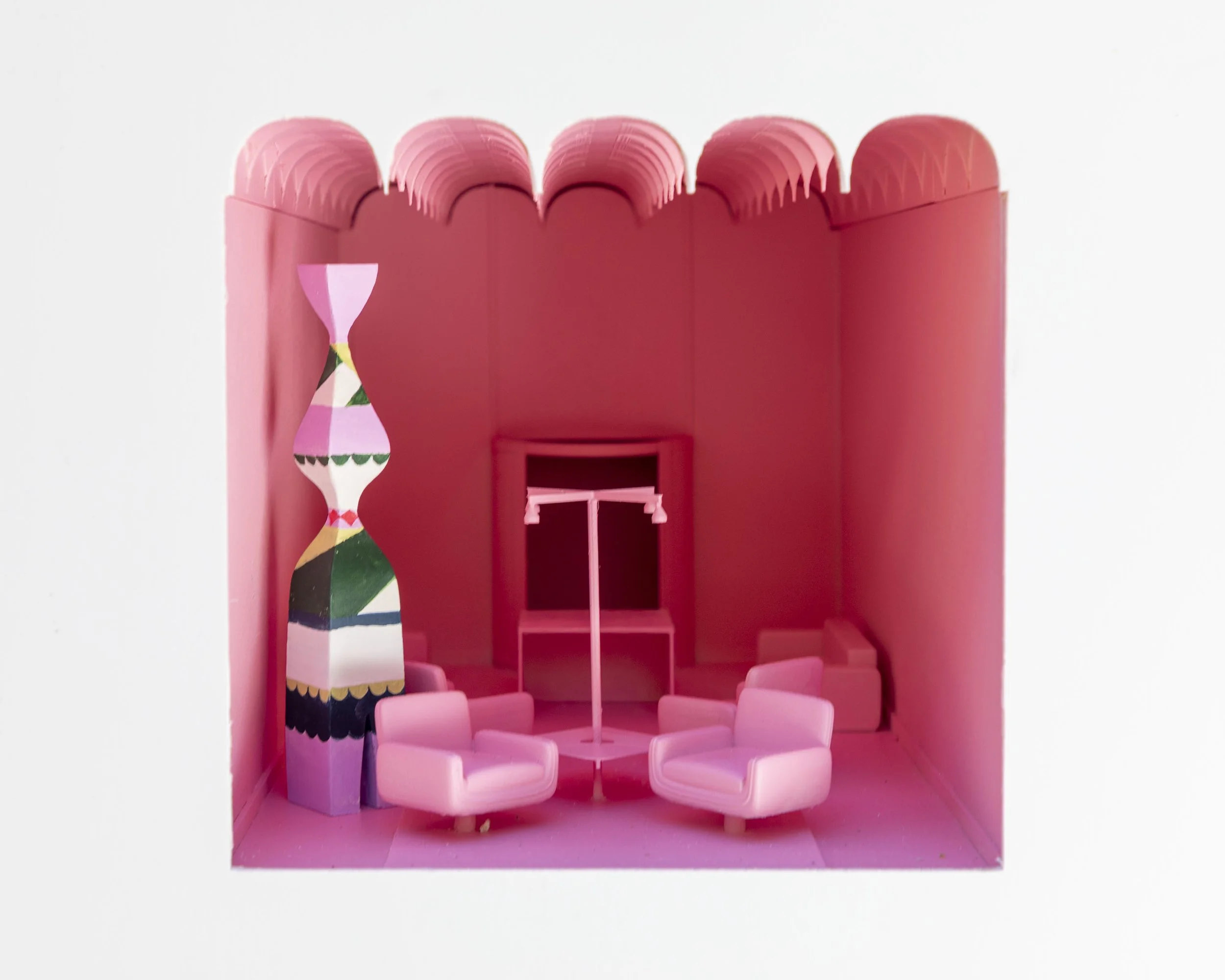
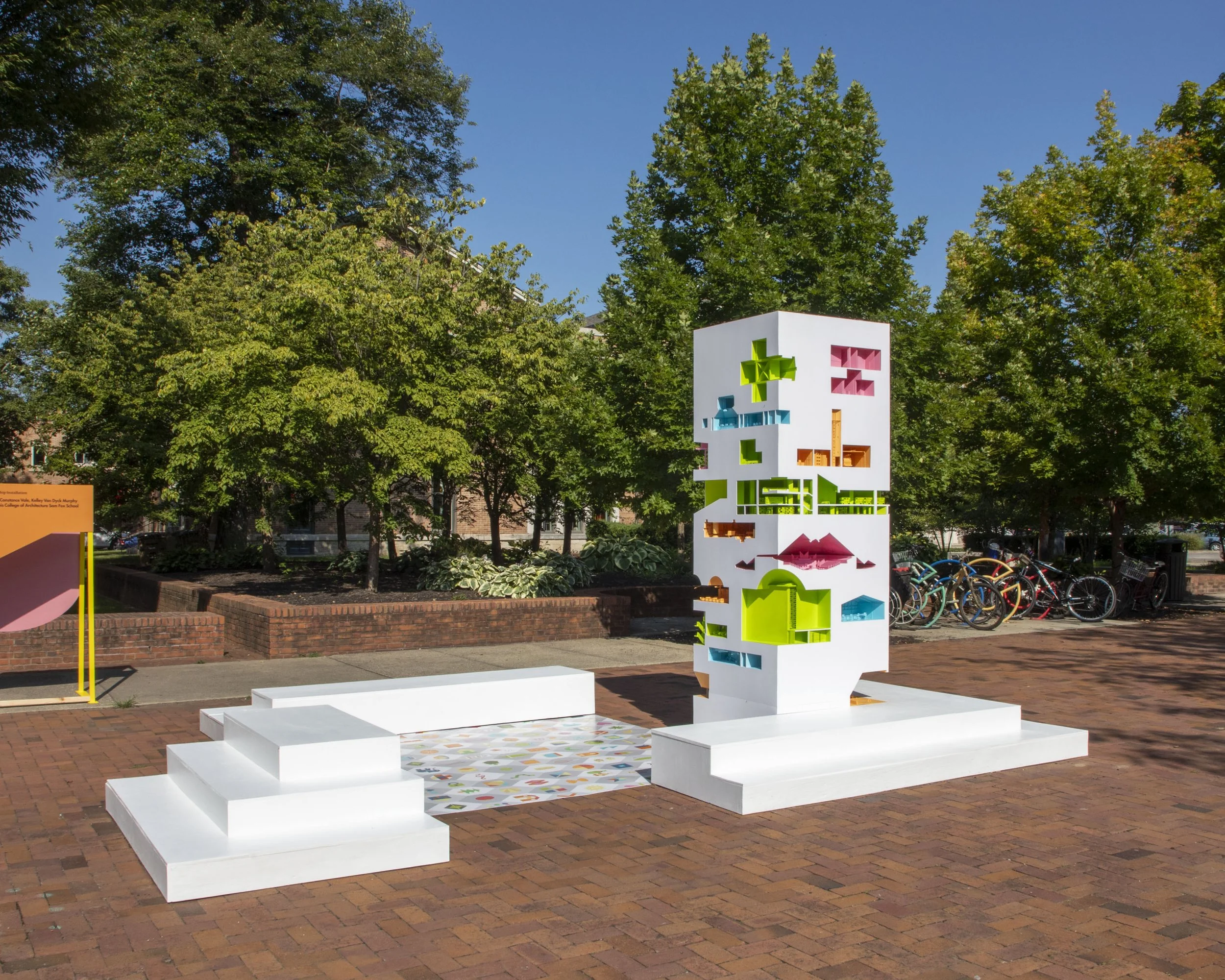
Presented by
Johnson Ventures
Site
Cleo Rogers Memorial Library
Partner
Bartholomew County Public Library and Columbus Area Visitors Center
Materials
CNC-milled plywood, Laser-cut acrylic, 3D-printed PETG, Expanded PVC, Vinyl, Paint
Team
Constance Vale, Chandler Ahrens, Kelley Van Dyck Murphy; Fabrication Manager Dylan Wei; Fabrication Team Nathan Arundel, Amelie Born, Mercy Fey, Dylan Wei, and Erika Yanou; Research and Digital Modeling Team Nathan Arundel, Frances Bobbitt, Amelie Born, Mercy Fey, Jiahe Jin, Holy Kim, Linda Li, Harry Park, Dylan Wei, Erika Yanou, Mia Yuguchi, Zoe Zuo
Fabrication Support
Facilities at Sam Fox School of Design and Visual Arts at Washington University in St. Louis
Additional Support
Students from L. Frances Smith Elementary School, Mt. Healthy Elementary School, and The Alberti Program: Architecture for Young People at Washington University in St. Louis, in partnership with PGAV Destinations, City of Columbus Department of Public Works
Learn more and watch the short animated video of Inside Out.
Installation Credits
About the Fellows
-

Chandler Ahrens, AIA, is an Associate Professor at Washington University in St. Louis and a founding partner at AVV A. His research focuses on the intersection of material investigations, environmental phenomena, and computational design processes. Chandler co-founded OSA and a senior project designer at Morphosis Architects. He has been a Visiting Professor at the Confluence Institute for Innovation and Creative Strategies in Lyon, France and previously taught at Woodbury University in Los Angeles.
-

Constance Vale is a registered architect and a founding partner of AVV A. She is also the Chair of Undergraduate Architecture and an Associate Professor at Washington University in St. Louis. Her research and creative practice span the interdisciplinary space between architecture, art, theater, and technology. Constance is also the editor and co-author of Mute Icons & Other Dichotomies of the Real in Architecture. She received a MacDowell Fellowship to develop her manuscript Digital Decoys: An Index of Architectural Deceptions. She has held previous teaching appointments at SCI-Arc and University of California, Los Angeles. Vale earned a Bachelor of Fine Arts from Parsons School of Design and a Master of Architecture from Yale School of Architecture.
-

Kelley Van Dyck Murphy (Team Lead) is an Assistant Professor of Architecture at Washington University in St. Louis and a founding partner of AVV A. She is the director of WashU’s Alberti Program: Architecture for Young People and the pre-college Architecture Discovery Program. Her design-based research explores the use of material processes and emerging technology to engage themes of identity, authorship, and context. This work often takes form through translation, exploring how material practice and craft are entwined with larger cultural narratives.
2025 Exhibition Field Guide
Interview with Chandler Ahrens, Constance Vale, and Kelley Van Dyck Murphy
University Design Research Fellows from Washington University knew quite a bit about Columbus when they began planning their project. Constance Vale brings her second-year WashU architecture students here each year for a field trip. Chandler Ahrens had come on a family vacation and recalls his daughters loved Zaharakos Ice Cream Parlor as much as he loved the buildings. Kelley Van Dyck Murphy knew about Alexander Girard and admired his work.
When they met to decide what their project focus would be, it took them only 15 minutes to decide on the dollhouse that Girard created for the Miller House. They said that meeting was the most fun they had in the year since they established their AVV A architecture practice. The project was ideal for the team’s areas of interest and expertise: Murphy’s in cultural material and practices, Ahrens’ in digital fabrication and technology, and Vale’s in miniatures and architectural representation.
In the vein of celebrating Girard, they wanted to focus on textiles, interiors, and furniture, which they believe have been considered less important than architecture by historians and preservationists. They wanted to point out the challenging legacies of architecture, that even today only 25 percent of licensed architects are women and that interior and textile design are still considered to be “women’s work.” Their project includes the interiors of women architects who have worked in Columbus, such as Susana Torre and Deborah Berke.
“We wanted to elevate their spaces,” Vale said. “We’d really love to see the discipline and architecture education be more diverse.”
Another goal was to involve children with architecture by way of their work. They especially wanted kids to get to see places where they don’t usually get to go.
“We were surprised that children weren’t allowed in the Miller House,” Vale said. “But in a fun twist, their schools live in our dollhouse and are something they can identify.”
During their visit last fall, they met with third- and fourth-grade art students at Smith and Mount Healthy Elementary Schools to tell them about Girard as well as to enlist their help. They gave the children templates so that they could design dolls and carpet tiles with a personal or Columbus connection (ala Girard) that the team later incorporated into the project.
They took the local children’s work back to St. Louis and the Alberti Program: Architecture for Young People, which Murphy runs at Wash U, to introduce fourth- through eighth-graders to architecture each June. Those students 3-D printed and painted the dolls that their Indiana counterparts had created—one for the house that will stay in Columbus and an extra for the local creator to keep—“a little bit like having a pen pal,” Murphy said.
“Making the dolls is about seeing themselves in these spaces,” she said. “There is a history of people being excluded from certain places, and now everyone can see themselves there. We are democratizing the spaces so that children and others get to see things they don’t have access to.”
The dollhouse tower makes colorful references to 19 interior architectural spaces in significant buildings around Columbus—from churches and fire stations to schools to the former Republic Building and the Miller House itself. The main structure is constructed of plywood like that used in kitchen cabinetry, fashioned with a computer-controlled router to cut it accurately and using the traditional furniture-making technique of mortise and tenon.
Replicas of the interior spaces were created by a combination of laser-cut acrylic and 3-D printers for the more complex geometries. The team selected materials in part for their ability to resist extreme weather conditions since they hope the tower will have a life beyond Exhibit Columbus.
The color palette they chose reflects spring colors at the Miller House—pink, green, orange, and robin’s-egg blue. Because of the site’s location near the Bartholomew County Public Library, Visitors Center, and First Christian Church, their representations on the tower are configured so that visitors can see the model against the actual building. Vale said they are grateful for their site because it is near places where people can go to learn about Columbus, and Murphy added that they hope once people see the tower they will be inspired to visit the architectural masterpieces it depicts.
The tower sits on a waterproof carpet created from the tile square designs made by the students. Around it is a terraced playground that allows children to climb up and look inside. Their hope is that, along with kids getting a look at places they wouldn’t ordinarily see, adults will feel playful as they interact with the design.
“We thought a lot about Yes And, Murphy said. “We said yes and to Girard and how he inspires us and how we feel like we are designing with him, yes to the City of Columbus and the spaces there, where it is always ‘Yes And’ and never ‘Yes But.’"
2024 Symposium
University Design Research Fellows participated in a panel discussion about their work.
2025 Design Presentations
The Fellows present Inside Out to a public audience at City Hall.

Previous Work by the Fellows
Flora Field
Flora Field is a digitally designed and fabricated reconsideration of architectural ornament in the form of a 3D-printed terracotta screen wall located in the courtyard of Adler and Sullivan’s iconic Wainwright Building. The Wainwright Building, known for its elaborate architectural ornamentation, is clad in terracotta formed by casting clay in individual hand-carved molds. This process has largely remained the same for centuries. By reconceiving the casting process of the Wainwright Building ornament as an additive 3D printed material system, the project explores the role of emerging digital technologies with an understanding of the history of clay-based building materials. This process replaces the unsustainable, fixed plastic materials of traditional 3D printing with clay: a sustainable, locally sourced, and reusable medium with deep roots in St. Louis’s rich architectural history. The project references Sullivan’s ornamentation while aspiring to engage passersby, instilling a new relationship with this historical building and downtown St. Louis.
Mini City
The Mini City is an immersive environment in which building form, public space, material characteristics, and atmospheres are controlled and transformed over time, similar to a film set. Research is being conducted in the environment to test future urban design and architecture proposals related to the development of smart technologies in cities. In order to work in relation to autonomous agents and machine vision, the project composites digital and hand fabrication techniques that shape three-dimensional form with those that apply two-dimensional color and image—3D printing, laser cutting, CNC routing, and wood shop tools—to best achieve equivalency with real-world conditions. Material qualities like color, texture, sheen, opacity, translucency, albedo, and luminosity are tuned to sensing technologies and layered onto architectural form and urban space.
View Finder
View Finder is a permanent installation commissioned by 21c Museum Hotel for their location in St. Louis, Missouri, in 2023. View Finder acts as a vision machine that directs visitors’ eyes to key views and creates a continuously transforming image of the surrounding city. Located on the edge of an elevated plaza, the large mass disrupts the view to the surrounding city and is punctured by a series of four voids lined with polished stainless steel. Each void is aligned to a specific view and its geometry is tuned to reflect certain elements in the environment, juxtaposing reflected flipped views with clear views that creates a kaleidoscopic effect. Our ocular lenses flip our view of the world on our retina, but our brain inverts that to perceive the world right-side up. View Finder requires us to think about the perception of images to understand the world around us and our position in it.
